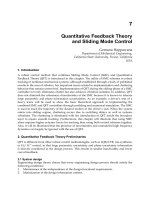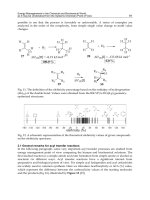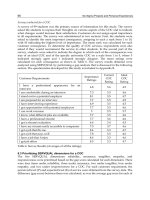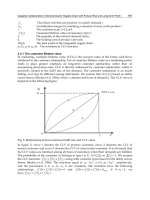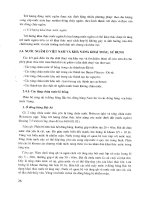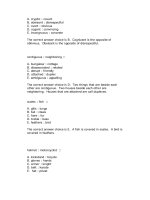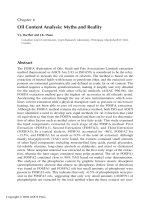Governing Fundamentals and Power Management phần 6 potx
Bạn đang xem bản rút gọn của tài liệu. Xem và tải ngay bản đầy đủ của tài liệu tại đây (398.18 KB, 10 trang )
Manual 26260 Governing Fundamentals and Power Management
Woodward 45
Assuming φ continues to rotate at a constant rate, and that the circuit-breaker
time delay (T
b
), the synchronizer window (φ
w
), and selected synchronizer window
dwell time (T
wd
) are known, the worst case value which the synchronizer will
allow (φ
s
) can be predicted. φ
s
is equal to φ at the time the synchronizer issues
the breaker closure command (φ
w
in the worst case) plus the change in φ due to
the rate of change in φ times the breaker delay (T
b
in the worst case). Therefore,
φ = φ
wc
when φ (at the instant the breaker closure command is issued) = φ
w
. The
rate of change of φ (φ/s) is the total degrees in the window divided by the dwell
time of the window or
2
õ
.
T
w
wd
then = = +
2
T
(
T
)
wc s w
w
wd
b
θθθ
θ
For Example:
Assume a synchronizer configured for a window of ±10 degrees and a window
dwell time of 1/2 second. Assume the breaker is never slower than 13 cycles.
If
θ
w
= 10°
T
wd
= 0.5 s
Tb =
13 cycles
60 cycles/second
= 0.217 s
then = = 10 +
2(10 )
0.5 .
(0.217 .)
= 18.7
wc s
wc
Θ
Θ
θ
°
°
°
sec
sec
In comparison, a window of ±5° and a window dwell time of 1 second, using the
same breaker.
==5+
2(5 ) (0.217 .)
1 .
=7.2
wc s
wc
θθ
θ
°
°
°
sec
sec
Figure 7-9. Phase Angle Relationship
Governing Fundamentals and Power Management Manual 26260
46 Woodward
Chapter 8.
Managing Power for the Desired Result
Peaking or Peak Load Control
Peak sharing, peaking, or peak load control all refer to methods used to limit the
peak electrical demand purchased from a utility. Electrical rates usually are
determined by the peak demand on the utility during a given time period.
Sometimes a peak demand lasting as brief as fifteen minutes out of a 30-day
period will determine the charge leveled for all power purchased during those 30
days.
How Is Peak Sharing, Peaking, or Peak Load Control
Accomplished?
Normally, peak load control is accomplished by one of four methods:
• Plant load control or load shedding, which means the shutting off of optional
loads to hold peak consumption below a maximum desired load level.
• Separating off and isolating a portion of the plant load and then powering
that isolated portion with an in-plant generating system. Ensure that the
plant generator load is a sufficient part of the total load to maintain the utility
load below the maximum desired peak.
• Base loading an in-plant generator system which is paralleled to the same
plant load supplied by the utility. Set the output of the in-plant generator high
enough to ensure that the utility load will not swing above the desired
maximum.
• Peak shaving, using an in-plant generator system controlled to take all loads
or peaks above a certain level. The utility will take all loads below this level
(see Figure 8-1).
Base-Loading
Base loading and peak shaving both use base loading techniques: base loading
by setting a block or constant load on the in-plant engine generator system, peak
shaving by varying the base load to maintain the level of power supplied from the
utility at or below a certain level.
Base-loading is the operation of an engine-generator at a constant output. When
internal power demand exceeds generator output capacity, deficit power will be
imported from the utility. The user's equipment is tied to the utility and uses the
utility to control frequency. Base-loading usually is accomplished with the user's
equipment in droop with the utility accepting load swings. Equipment is available
that will allow the user to operate in isochronous mode with the utility and still
allow the utility to accept load swings.
If the base-loading exceeds the plant’s internal power demands, the excess
power may be exported to the utility.
Manual 26260 Governing Fundamentals and Power Management
Woodward 47
Figure 8-1. "Peaking" or Peak Load Control
Governing Fundamentals and Power Management Manual 26260
48 Woodward
Figure 8-2. Base Loading
Peak Shaving
Peak shaving is used to set a limit on the maximum amount of imported power.
In the following example, a limit of 100 kW is set for imported power, and the
user's generating equipment provides for power demands exceeding the 100 kW
limit. The in-plant engine generator is normally operated only during periods of
peak power demand.
Figure 8-3. Peak Shaving
Import/Export
Import power and export power are terms used to describe power that is brought
into a plant (import) or is sent to a utility (export). A plant may import power
during peak demands and export during low demands. Other situations may
require only import power or only export power.
Manual 26260 Governing Fundamentals and Power Management
Woodward 49
Figure 8-4. Import Power
Figure 8-5. Import Power (Constant Level)
Figure 8-6. Export Power
Governing Fundamentals and Power Management Manual 26260
50 Woodward
Figure 8-7. Export Power (Constant Level)
Zero Import (Export) Control
A generator—or series of generators—is able to supply all electrical power
required for plant operations. The generator is tied to the utility for frequency
control and for emergency situations. Normally power is not exported to, nor
imported from, the utility. This situation usually necessitates the start-up or
shutdown of engines as power demands fluctuate. Operating isochronous base
load, any number of engine generators can be connected to isochronous load
share, with the complete system base loaded against the utility.
Figure 8-8. Import/Export Control
Figure 8-9. Zero Import/Export
Manual 26260 Governing Fundamentals and Power Management
Woodward 51
Cogeneration
What Is Cogeneration?
Cogeneration normally is defined as the combined production of electrical or
mechanical power and useful thermal energy through the sequential use of
energy.
Systems that burn some form of fuel (combustion energy) to generate electrical
power often only produce power outputs of 40% or less of the total fuel energy.
Unless power management in the form of cogeneration is used, the remaining
energy is lost. This loss is in the form of thermal energy such as exhaust heat
and friction heat. With proper applications of cogeneration, much of this lost
energy can be recovered and used in applications where a source of heat is
required.
Generated electrical power may be recycled into the manufacturing process, or
qualified producers may sell it to a utility company. The type of manufacturing
process, and its needs, will determine how generated power is distributed.
How Is Cogeneration Accomplished?
Two recognized cogeneration cycles are the "topping cycle" and the "bottoming
cycle."
The topping cycle is a method by which fuel is consumed to drive a prime mover
coupled to a generator or other device to produce electricity or shaft power. The
heat generated in this process then is used for plant processes.
The bottoming cycle is a method by which waste heat generated during a plant
process is used to generate electricity.
Cogeneration can increase the efficient use of energy or fuel by as much as
50%.
Single Engine AGLC–Base Load Control
(See Figures 8-10, 8-11, and 8-12)
In this application, a single engine can be automatically synchronized and base
loaded into the utility. This unit, if the utility tie is broken for any reason, will also
operate isochronously, carrying the plant load up to the engine's capabilities.
The following is a typical series of events.
The engine is started under governor control and warmed up at idle speed. After
the warm-up period, the engine is ramped up to synchronous speed. The
generator field is excited and output voltage is developed. Once the SPM-A
synchronizer senses generator voltage, and assuming the utility-to-plant load tie
is closed and SPM-A run mode has been selected, the SPM-A begins matching
speed, phase, and voltage with the utility. When the requirements of the SPM-A
are matched, it issues a one second generator breaker closure command signal
to close the breaker. At the same time, auxiliary breaker contacts close and
activate the AGLC (Automatic Generator Loading Control).
Governing Fundamentals and Power Management Manual 26260
52 Woodward
The AGLC unit load sharing output lines, which are connected to the 2301A load
sharing lines, start at zero Vdc and ramp up to the setting of the base load
setpoint potentiometer. This AGLC output forces the engine, through the 2301A,
to pick up the desired load. If utility power were now lost and the utility tie breaker
opened, the AGLC would be automatically de-activated, removing the bias from
the load sharing lines. The engine would then automatically carry the plant load,
within its capabilities at synchronous speed.
When the utility power returns, the SPM-A, sensing voltage, would automatically
begin synchronizing the engine, and once satisfied, close the utility tie breaker,
re-activating the AGLC. The AGLC, tracking the load sharing lines, would start
out at the plant load at that time, causing no load bump, and ramp the load up or
down, back to its base load reference setpoint.
To unload the engine, the AGLC unload contacts are momentarily opened. The
AGLC ramps the load off the engine and back onto the utility. Once the engine's
load is down to the unload trip level setpoint, the AGLC issues a generator
breaker open command. The generator circuit breaker opens and the engine is
isolated from the load. The utility now has the system load and the engine can be
shut down.
These controls provide a means to totally automate an engine to start, run, load,
unload, and shut down, using simple relays, timers, and circuit breaker auxiliary
contacts.
Manual 26260 Governing Fundamentals and Power Management
Woodward 53
Figure 8-10. Synchronizing to Utility or Plant Bus
Governing Fundamentals and Power Management Manual 26260
54 Woodward
Figure 8-11. Synchronizing Gen Set to Plant Bus or to Utility
